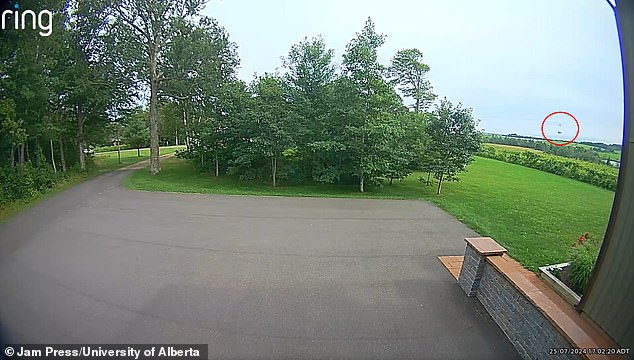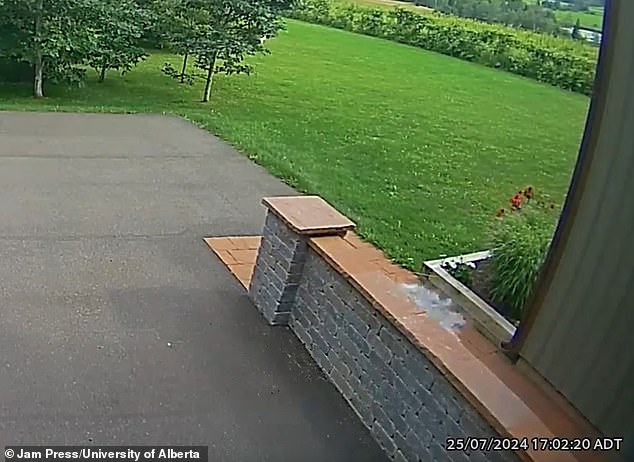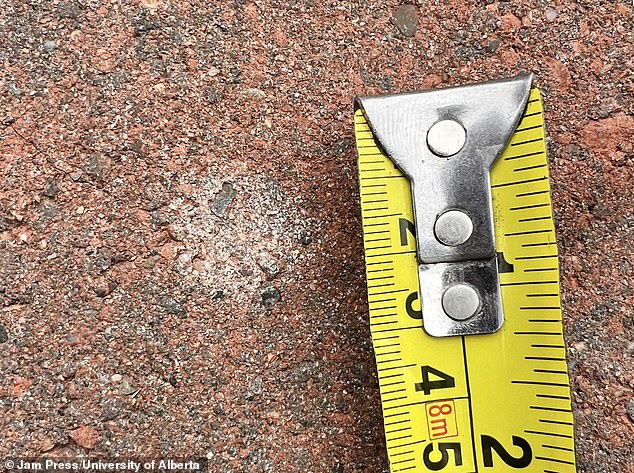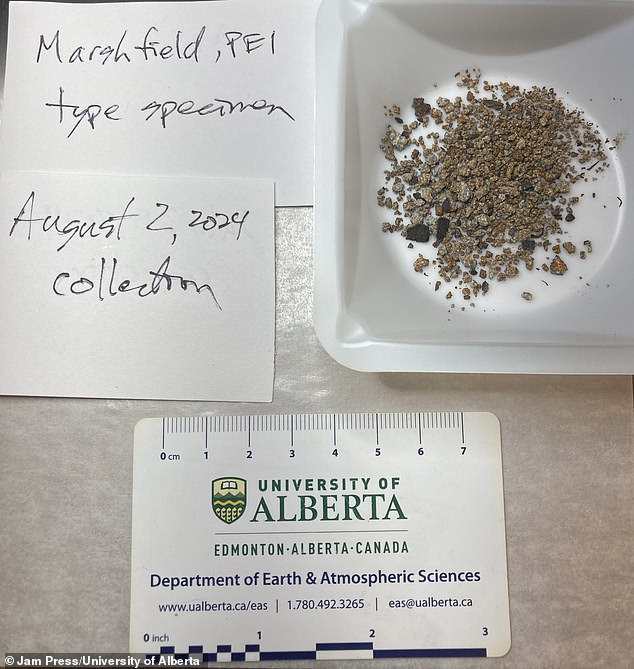From floating ghosts to potential UFOs, Ring doorbells have captured a lot of strange events.
Now, one couple’s home security camera has recorded something entirely new to science.
For the first time ever, the terrifying sound of a meteorite striking the Earth has been revealed.
The groundbreaking video shows the exact moment a chunk of space rock hit the driveway of a home in Prince Edward Island, Canada.
In July 2024, Laura Kelly and her partner Joe Velaidum had just returned from walking their dogs when they found a mysterious star-shaped mark outside their home.
Checking the recording from their Ring camera, they watched as a rock hurtled out of the sky and exploded into a burst of dust on the ground.
Thinking fast, the couple managed to gather up about seven grams of suspected space rock and sent it to Dr Chris Herd, head curator of the meteorite collection at the University of Alberta.
Dr Herd says: ‘No other meteorite fall has been documented like this, complete with sound.’

Residents of Prince Edward Island, Canada were baffled to find that their Ring doorbell had recorded the stunning moment a meteorite slammed into their driveway

The shocking video is the first time that the sound of an asteroid hitting Earth has ever been recorded
When the rock smashed into their home, it was moving so fast that the camera only captured it for a single frame.
However, as soon as Dr Herd looked at the samples, there was no question that this was no ordinary stone.
As luck would have it, Dr Herd already had a trip planned to the area just 10 days after the impact and was able to make a diversion to the site.
There, he found that the meteorite had blasted a 2cm x 2cm hole in the walkway outside the home.
With the help of Joe and Laura, Dr Herd collected 95 grams of asteroid material which is now being held for further study at the University of Alberta.
Dr Herd’s analysis shows that the rock, now dubbed the Charlottetown Meteorite after the capital of Prince Edward Island, was made of Chondrite – the most common meteorite material.
Chondrite meteors are leftovers from the formation of the solar system some 4.5 billion years ago and have lurked almost untouched since then in the distant reaches of space.
This particular rock would have begun its long journey to Canada in the asteroid belt between Jupiter and Mars, around 204 million miles (329 million kilometres) from Earth.

In July 2024, Laura Kelly and her partner Joe Velaidum had just returned from walking their dogs when they found a mysterious star-shaped mark outside their home
This was particularly exciting since this is the only recorded meteorite impact in the island’s history.
Dr Herd says: ‘As the first and only meteorite from the province of Prince Edward Island, the Charlottetown Meteorite sure announced its arrival in a spectacular way.
‘It adds a whole new dimension to the natural history of the Island.’
But most excitingly of all, this is the only time the sound of a meteorite impact has ever been recorded.
Dr Herd told CBC News: ‘It’s not anything we’ve ever heard before. From a science perspective, it’s new.’
The violent crack of the impact which you can hear in the video is a product of the Charlottetown meteorite’s incredible speed.
Meteorites typically arrive at the edge of Earth’s atmosphere travelling at over 37,000 miles per hour (60,000 kmph) before slowing down.
Dr Herd estimates that the Charlottetown Meteorite was probably moving at around 125 miles per hour (200 kmph) when it hit the ground.

The meteorite is believed to have hit the ground at around 125 miles per hour (200 kmph), producing enough force to gouge a 2cm hole into the walkway
Although the meteorite wasn’t big enough to cause any serious damage to the property, it could have been quite dangerous, had Joe and Laura been nearby.
‘The shocking thing for me is that I was standing right there a couple of minutes right before this impact,’ says Joe.
‘If I’d have seen it, I probably would’ve been standing right there, so it probably would’ve ripped me in half.’
Despite being a first for Prince Edward Island, events like this are actually surprisingly common.
Dr Greg Brown, Senior Public Astronomy Officer at the Royal Observatory Greenwich, says: ‘Meteors fall into the Earth’s atmosphere very often. Millions of minuscule particles of dust and rock burn up in the atmosphere each day, totalling around 15 thousand tonnes of material over the course of a year.
‘If those particles are large enough, they can survive their entry to the atmosphere and impact the Earth with recent estimates suggesting around 17,000 impacts occur each year.’
However, most of those are so small that they arrive at the Earth’s surface as grains of dust, having burned away their outer layers.
Although impacts with human settlements are rare, scientists estimate that there are around two ‘damaging impacts’ every year.

Further analysis at the University of Alberta shows that the meteorite (pictured) is made of Chondrite, a material left over from the formation of the Solar System 4.5 billion years ago
One family from Stratford-upon-Avon, Warwickshire found that their windshield had been smashed by an iron-rich meteorite on Boxing Day last year.
Likewise, in 2019 scientists confirmed the first ever ‘damaging impact’ in Uruguay after a 712-gram stone broke through the cement ceiling of a home, shattering a TV and bed frame below.
While no one has ever been killed by a direct impact from a meteorite, in 1953 an American woman named Ann Elizabeth Fowler Hodges became the first and only person to ever be hit by a space rock.
According to investigations at the time, a 3.8kg (8.5lbs) rock shot through the roof of her home, hit a radio console and bounced into her side.
The impact left Ms Hodges with severe bruising and the unique claim to be the only person ever directly injured by a meteor impact.
However, given how large the planet is and how little of it is actually inhabited, there is little reason to worry about these kinds of small impacts.
‘The vast majority of meteorites are far smaller, limiting the potential damage they could do,’ Dr Brown added.
‘What’s more, despite how widespread humanity is, the majority of the surface of the Earth is ocean, desert and other similarly sparsely inhabited places, meaning most impacts aren’t even noticed, let alone pose a threat to life and health.’








